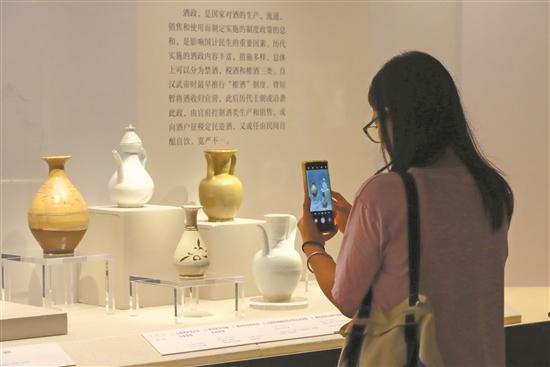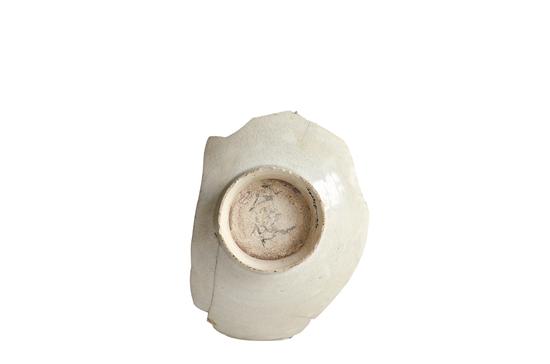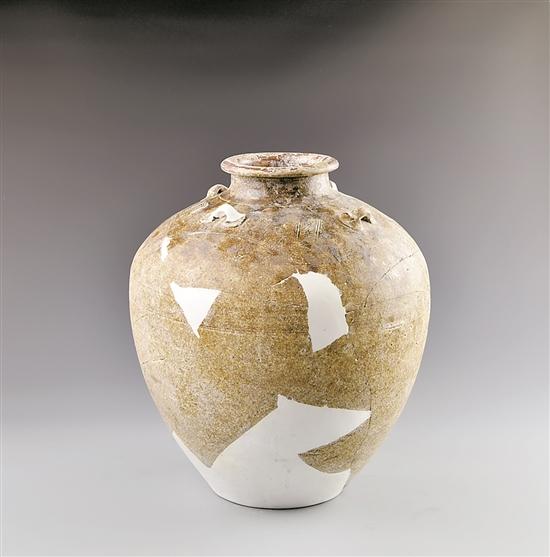
Recently, the exhibition titled "Fragrance of Liquor—The Song Dynasty Official Liquor Cellar in Guangzhou and Chinese Liquor Culture" opened at the Nanyue King Museum's Royal Tomb Exhibition Area. The exhibit centers on the discovery and research of the Song Dynasty official liquor cellar in Guangzhou and features 306 items, including archaeological finds related to liquor brewing, storage, distribution, and drinking. Spanning various periods and offering a rich variety of items, the exhibit explores the deep connection between Guangzhou's liquor vessels, famous liquors, and the Maritime Silk Road.

At the entrance to the exhibition hall, visitors are greeted by a stone wellhead from the Guangzhou Official Liquor Warehouse in Song Dynasty. Li Zaoxin, the deputy director of the Nanyue King Museum, likened the warehouse to an "ancient government reception office". The liquor used to entertain visiting officials, foreign envoys, and merchants was produced by the official liquor warehouse.
With its port advantages, Guangzhou became a crucial stop for ships traveling between the East and West during the Northern Song Dynasty. More than 800 years ago, "Nanhai No.1", the famous ship in Southern Song Dynasty, docked in Guangzhou before it sank, loading vast quantities of both official and private liquor intended for maritime trade.

Archaeological research confirms that many dark-glazed liquor jars found in the wreck of "Nanhai No.1" and the government liquor storehouse in Song Dynasty at the Nanyue Palace Site are of identical design. These jars were also discovered at Foshan Nanhai Kilin and Wentouling Kilin. This suggests that such jars were custom-made at the Nanhai kilns for both government and private breweries in Guangzhou at the time. Once filled with exquisite government and private liquor, these jars were shipped overseas aboard vessels like "Nanhai No.1".

Additionally, similar dark-glazed jars have been found at various Maritime Silk Road locations, including Hong Kong's Kowloon Hill site, the Java Sea shipwreck in Indonesia, and Singapore's Fort Canning site.
"These findings demonstrate that the Lingnan region during the Song Dynasty was a major producer of liquor. These products played a key role in ancient foreign trade, and the 'Maritime Silk Road' was also a 'Liquor Road'," said Li Zaoxin.
Source :Lingnan on the Cloud
在南越王博物院一站式了解中国美酒文化
日前,“酒香飘四海——宋代广州公使酒库与中国酒文化”展览在南越王博物院王墓展区展出。该展览以宋代广州公使酒库的发现和研究为切入点,共展出306件(套)展品,以考古出土的酿酒、贮酒、分酒和饮酒器具等文物展品为主,年代跨度大且展品类型丰富,讲述了广州酒器、名酒与海上丝绸之路的不解之缘。
走进展览序厅,宋代广州公使酒库水井的石井栏就陈列在入口处。南越王博物院副院长李灶新将公使酒库形象地比喻为“古代的地方政府接待办”,政府接待过往官员、外国使节和蕃商等需要的酒水,就是公使酒库生产的公使酒。
利用先天的港口优势,北宋时期的广州成为东西方往来船舶的重要站点。八百多年前,著名南宋船舶“南海Ⅰ号”沉没前就曾靠岸广州,并在这里装载大量广州生产的公使酒和私酒准备远洋贸易。
经研究确认,“南海Ⅰ号”沉船遗址与南越国宫署遗址宋代公使酒库出土了大量形制相同的酱釉酒罐。它们在佛山南海奇石窑、文头岭窑中也均有发现。由此可确认这类酱釉酒罐是当时广州官方或私人酿酒作坊在南海窑定制的。在装满公使酒和私酒佳酿后,它们又随同“南海Ⅰ号”等商船销往海外。
不仅如此,香港九龙圣山遗址、印度尼西亚爪哇沉船、新加坡福康宁遗址等海上丝绸之路沿线沉船和港口遗址也发现了此类酱釉罐。
“由此可见,宋代岭南地区盛产美酒,这些产品是古代中外贸易的重要商品,‘海上丝绸之路’也是‘美酒之路’。”李灶新说。
文 | 羊城晚报记者 文艺
图 | 羊城晚报记者 何文涛
译 | 赵凡
审 | 林佳岱
-
I See China丨International students marvel at the future while riding in Guangzhou-Made 'flying taxi'
2024-09-22 13:00:53 -
Video | Dialogue with AI and exploration of China spallation neutron source:Guangdong Science Carnival kicks off
2024-09-21 22:29:38 -
The list of 2024 Guangdong's top 500 enterprises is out, with growth in both revenue and net profit
2024-09-21 22:27:09 -
68-years-old Grandma Yang from a rural area has become a drummer
2024-09-21 22:27:08






